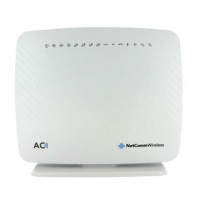k) Enter a Destination IP Address if the connection is to a single device. This is useful for VPN connections. If you wish the
destination IP address to be any address leave the field blank.
l) Enter a Destination Subnet Mask if you have entered a Destination MAC address and Destination IP address. This would
normally be 255.255.255.0 unless your system administrator advises otherwise. If you have not entered a Destination
MAC or IP address leave the field blank.
m) Set the Differentiated Service Code Point (DSCP) Check to AF11(001010).
n) Set the Protocol to TCP. Other options include UDP, ICMP or IGMP.
o) Set “Assign Classification Queue” to Priority 3 (in the example above pppoa0&atm0&Path0&Key39&Pre3). Other options
are priority 1 and 2. Priority 1 gives the highest priority with priority 3 being the lowest.
p) Set Mark Differentiated Service Code Point (DSCP) as AF11(001010).
q) Set Mark 802.1p Priority as 0. In the scale 0-7, 0 is best effort, 6 and 7 are reserved for networking performance so set 0
as the lowest priority.
r) Click the Apply/Save button.
s) You now have 2 Quality of Service rules implemented for 2 devices connecting to the NF17ACV router.
t) Select Management > Reboot. Click the Reboot button to restart the router and save the new settings.
u) To test your Quality of Service settings try running speed-tests (http://speedtest.net) on both PCs/devices simultaneously.
Limiting the upstream rate
a) By default, a QoS queue is created when a WAN interface is created but it is disabled by default. On the QoS Queue
page, enable the queue for the appropriate WAN interface.
b) On the QoS Classification page, add a rule to limit the upstream rate, for example:
Classification Criteria:
Class Interface: LAN
Ether type: IP
Classification Results:
Class Queue: the queue that was enabled in Step 1
Set rate-limit: set according to your preference

